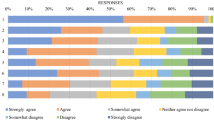Abstract
Laland and colleagues have sought to challenge the proximate–ultimate distinction claiming that it imposes a unidirectional model of causation, is limited in its capacity to account for complex biological phenomena, and hinders progress in biology. In this article the core of their argument is critically analyzed. It is claimed that contrary to their claims Laland et al. rely upon the proximate–ultimate distinction to make their points and that their alternative conception of reciprocal causation refers to phenomena that were already accounted for by standard theory.
Similar content being viewed by others
References
Autumn K, Ryan MJ, Wake DB (2002) Integrating historical and mechanistic biology enhances the study of adaptation. Q Rev Biol 77(4):383–408
Davies NB, Krebs JR, West SA (2012) An introduction to behavioural ecology, 4th edn. Wiley Blackwell, Oxford
Dennett DC (1995) Darwin’s dangerous idea. Allen Lane, London
Dickins TE, Rahman Q (2012) The extended evolutionary synthesis and the role of soft inheritance in evolution. Proc R Soc B. doi:10.1098/rspb.2012.0273
Harvey PH, Pagel MD (1991) The comparative methods in evolutionary biology. Oxford University Press, Oxford
Huxley J (1942) Evolution: the modern synthesis. Allen and Unwin, London
Laland KN, Sterelny K, Odling-Smee J, Hoppitt W, Uller T (2011) Cause and effect in biology revisited: is Mayr’s proximate–ultimate dichotomy still useful? Science 334:1512–1516
Laland KN, Odling-Smee J, Hoppitt W, Uller T (2012) More on how and why: cause and effect in biology revisited. Biol Philos (forthcoming)
Mayr E (1961) Cause and effect in biology: kinds of causes, predictability, and teleology are viewed by a practicing biologist. Science 134:1501–1506
Müller GB (2007) Evo-devo: extending the evolutionary synthesis. Nat Rev Genet 8:943–949
Nunn CL (2011) The comparative approach in evolutionary anthropology and biology. University of Chicago Press, Chicago
Odling-Smee FJ, Laland KN, Feldman MW (2003) Niche construction: the neglected process in evolution. Princeton University Press, Princeton
Pagel MD (1999) Inferring the historical patterns of biological evolution. Nature 401:877–884
Pigliucci M, Müller GB (2010) Evolution: the extended synthesis. MIT Press, Cambridge, MA
Scott-Phillips TC, Dickins TE, West SA (2011) Evolutionary theory and the ultimate-proximate distinction in the human behavioral sciences. Perspect Psychol Sci 6:38–47
Acknowledgments
The writing of this paper benefitted from discussions and correspondence with Claire El Mouden, Qazi Rahman, Thom Scott-Phillips, Phillip Stephens and Stuart West. We should also like to thank Kim Sterelny for useful editorial comments. All errors are our own.
Author information
Authors and Affiliations
Corresponding author
Rights and permissions
About this article
Cite this article
Dickins, T.E., Barton, R.A. Reciprocal causation and the proximate–ultimate distinction. Biol Philos 28, 747–756 (2013). https://doi.org/10.1007/s10539-012-9345-z
Received:
Accepted:
Published:
Issue Date:
DOI: https://doi.org/10.1007/s10539-012-9345-z




